As composers, our creative process is founded on intuition. We make many conscious and subconscious decisions during the conception and creation of a piece of art. Such intuitive creative decisions run like invisible stitching throughout our work – they hold it together, and though they are not the focus of our attention during the act of composing, they are imperative to creating a piece of music. It is not difficult to imagine how laborious the act of writing music would be if every decision were made consciously – where we deliberate over the nuances of each timbre, each sound’s duration, and create rationales for every aspect of the piece. We should embrace the intuitive subconscious decisions as they allow us to compose naturally and find a flow.
Through examining our own compositions, we can often see recurring themes and their presence can go unnoticed until pointed out to us. Many of these subconscious themes come from schemas that have been developed and ingrained in us over time.[1] Such schemas permeate our entire existence in every aspect of life.
There are many subconscious schemas we develop with language, for instance. How we find that tick-tock and clip-clop both feel correct but not tock-tick or clop-clip.[2] Many people such as Simon Emmerson[3] and Pierre Schaeffer[4], have likened music to a language, so it is not without reason that I draw the parallel. In language as well as in music, we develop a sense of what feels ‘right’ and what feels ‘wrong,’ often being at a loss to explain why we feel this way. However, society has not codified sounds in the same way as words – there is no sonic dictionary that provides the meaning of all sounds and timbres. The potential meaning of a sound could change drastically depending on the context and the individual perception of the listener. And yet, despite its non-codified nature, composers still maintain this sense of what sounds right or wrong.
Writing a programme note can be a useful exercise to recognise subconscious decisions. It is when we stop to consider our output that we realise things that were hiding from us. Even a piece that has been conceptualised in great detail is not immune to such realisations. We can feel disingenuous when it seems as though we are reverse-engineering our composition – when the piece has long since been finished but we pretend these recent realisations were conscious throughout the entire compositional process. I maintain that as long as there is a justification for these newly-recognised features, themes, or ideas, then there is no reason to exclude them. All characteristics of our compositions are worthy of being highlighted in a programme note.
Subconscious decisions are present throughout every aspect of the creative process, not just when we are working with sounds but also in the work’s initial conception. They are also present in the choice of media, be it audio-visual, installation, fixed media, a form of live performance or something else. Analysing how we choose to present or perform our work helps us to understand our own unique creative mind further. This new recognition allows us to become more familiar with our own tendencies, thus allowing us greater control over our creative actions. This control is desirable as once we highlight the tendencies of our intuition, we can then begin to work with them, shaping, accenting or eliminating them during our future compositions.
The framework that I have designed is intended to bring to light subconscious decisions, but it is in no way exhaustive. There is an infinite amount of ideas and inspirations to compose around and an endless number of ways to do so. Even if we succeed in bringing some subconscious tendencies or decisions to light, we can never expect to uncover all of them. The S.O.A.P. framework focuses on four selected elements: space, objects, agency, and place, each of which I will discuss in section two of this commentary.
The framework requires two parts in order to be effective: a diagram and a supporting commentary. The commentary supporting the diagrams provides the user with the opportunity to add details which the diagrams themselves cannot show, for example, changes over time. The diagrams on their own are useful for providing critical information quickly and conveniently and therefore rely on using abbreviations to refer to what are often complicated ideas. The diagrams are divided into two sections representing the performance environment and the digital environment. The performance environment is the area of the intended performance. This can be a venue (either inside or outside) or even a pair of headphones. It is where the composer intends their audience or listener to be located. The digital environment is unseen and uninhabitable. It is a concept rather than a physical space. Sounds that need to travel through loudspeakers in order to be heard come from the digital environment. Audio manipulations made using software happen in the digital environment. Depending on the piece in question, the positioning of the letters representing the four elements of S.O.A.P. will vary to denote where each element is present (see example diagrams below).
This framework is flexible and multifunctional both as a tool for analysis (post-composition), a tool for planning (pre-composition), and as a tool for revision and restimulation during the compositional process.
Considering space, objects, agency, and place after finishing a composition is useful for highlighting aspects of the composer’s creative process. We can treat these as if they are parameters and consider how we have explored each one. Perhaps in future compositions we may decide to focus more deeply on place or try new approaches to how we use space.
S.O.A.P. is also a valuable tool for planning as it encourages the composer to consider each of the four elements individually and survey performance options to find the one best suited to their ideas. I have found that by implementing S.O.A.P. as a planning tool in my own compositions, I have constructed interesting performance ideas such as changing the orientation of the audience (an in YinYang (2019-20)) or developing ways of challenging their perception of time and place (as in 57N (2018)).
In the following text I will provide definitions for the terms space, objects, agency, and place as well as further explaining the diagrams’ structure with reference to what I have called the digital environment and the performance environment. I will also provide rationales for developing the framework in the way that I have, and place the role of the listener within this context.
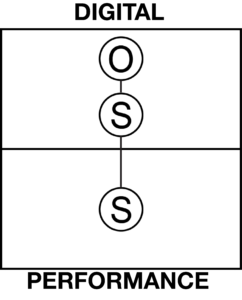
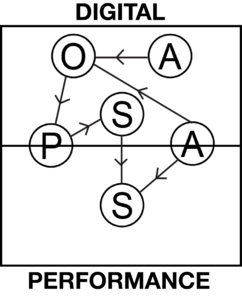
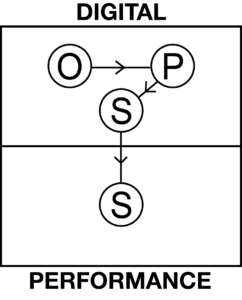
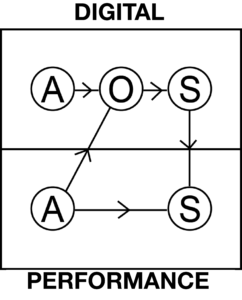
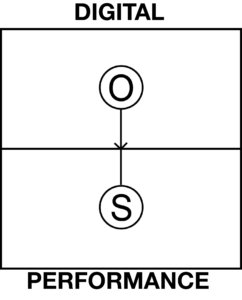
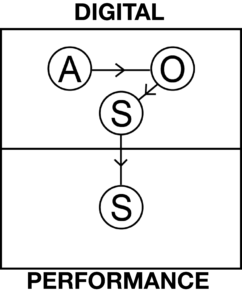
[1]Rosalyn Coull, ‘Emotion, Meaning & Narrative in Electroacoustic Music’ (Ph.D Thesis, University of Birmingham, 2015), pp. 6-7.
[2]This is the rule of ablaut reduplication. Mike Forsyth, The Elements of Eloquence: Secrets of the Perfect Turn of Phrase (New York: The Penguin Group, 2013), p. 66.
[3]Simon Emmerson, ‘The Relation of Language to Materials’, in The Language of Electroacoustic Music, ed. Simon Emmerson (McMillan Press Ltd., London, 1986), pp. 17-40.
[4]Pierre Schaeffer, Treatise on Musical Objects: An Essay Across Disciplines, Trans. By Christine North and John Dack, (Oakland: University of California Press, 2017) (Original work published Paris: Édition du Seuil, 1966).
